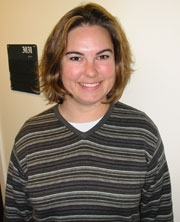
School:
Grade Level:
Teaching Position:
Supervisor:
Department:
Mentor:
Research Project Year:
Research Project Title:
Research Project Description:
Gallium Nitride has received a great deal of notoriety in the past few years due to its technological and defense applications. Research teams from around the world have been studying this semi conductor's physical, chemical, and electrical properties to better understand how to cheaply produce it for blue use in blue lasers. I have joined their quest as a summer researcher working with a team looking at its crystal structure, strain factors, and growth parameters.
One of the main goals that Phil Tavernier and I had was to better understand dislocation density in the crystal structure and how it relates to other chemical, physical, optical, and electric properties of GaN. In order to use GaN on a large scale the crystals need to have a low density of dislocations. Dislocations form as the crystal adheres to the substrate. SInce the substrate orientation and the crystal orientation do not perfectly match, dislocations occur. In thin films were few layers of crystals are present on the substrate dislocations are inevitable and not given a chance to grow out. As more layers are added to the substrate the misfit orientations can grow out ot the film but other problems arise. This is important because the strain fields around dislocations can alter the wavelengths of photoluminescence. Since blue lasers have a very specific wavelength any variability is undesirable.
With so many variables to work with I focused on the film thickness and how it relates to dislocation density. The crystals are grown at high temperatures in order to activate the needed reactions to grow GaN crystals on the sapphire substrate. Changing the growth parameters can modify film thickness. The amount of time the reactions are allowed to take place, temperature, and chemical concentrations are all factors that would effect film thickness. I had the opportunity to experiment with films that were from from 3 to 60 microns thick. It is hypothesized that crystal structure in thin films are under a great deal of stress an do not have good epitaxy. It is also though that very thick films have a high dislocation density due to thermal expansions and stress which can lead to cracking in the film's surface. My goal was to better understand the relationship that film thickness has to the dislocation density.
Curriculum Project Year:
Curriculum Project Title:
Curriculum Project Description:
This presentation is not just another slide show but a teaching technique to increase student learning. I will demonstrate how visual stimulation paired with scientific concepts will improve student performance.
Curriculum Project Attachments:
| Attachment | Size |
|---|---|
| 11 KB | |
| 295.19 KB | |
| 925.03 KB | |
| 593.5 KB | |
| 619.76 KB |
